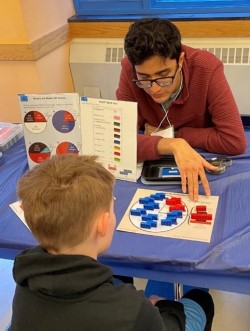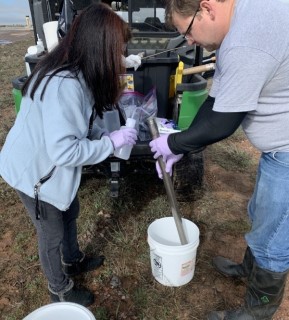Hot Off the Press
E-Factor Stories
New Technologies Connect Environmental Exposures to DNA Damage, Cancer: Improved understanding of factors driving DNA damage and repair may offer new clues for personalized disease prevention, according to Bevin Engelward, Sc.D., a biological engineer and director of the Massachusetts Institute of Technology SRP Center. Engelward shared insights from her research, which interrogates how genes and the environment can affect an individual's susceptibility to DNA damage, mutations, and, ultimately, cancer, during an April 6 NIEHS Keystone Science Lecture.
High-Fiber Diet May Protect Against Exposure to PFOS: A diet rich in fiber may decrease disease risks associated with perfluorooctane sulfonate exposure, according to researchers at the University of Kentucky. With funding from SRP, the team investigated how dietary fiber may play a role in gut microbiota-liver metabolism interactions.
Safer Water for Native American Communities: Columbia University SRP researchers recently installed water filtration systems in Tribal communities to reduce exposure to and the health effects of arsenic-contaminated drinking water. In collaboration with Johns Hopkins University, Missouri Breaks Industries Research, and Northern Plains Tribal Nations, the team installed arsenic filters under household kitchen sinks and launched a corresponding educational campaign.
Extramural Paper of the Month: DNA Mapping Reveals Genetic Variants Involved in Arsenic Metabolism: By analyzing DNA from people of different ancestries, researchers funded by SRP and other entities identified several inherited genetic variants that could influence individual sensitivity to arsenic exposure. The findings point to potential biological mechanisms underpinning arsenic toxicity.
Extramural Paper of the Month: Environmental Degradation May Increase Microplastics' Toxicity: Environmental factors, such as ultraviolet light, can alter the chemistry of miniscule plastic fragments, potentially increasing their toxicity on lung cells, according to a study from the University of New Mexico SRP Center. The findings offer clues into the health risks of exposure to plastic debris.
Extramural Paper of the Month: New Technology Can Remove PFAS From Water: Weaver Labs, an SRP-funded small business, developed a novel PFAS removal technology. According to the authors, their materials can be reused multiple times and are potentially less expensive than current remediation techniques.
Extramural Paper of the Month: DNA-Based Sensor Rapidly Detects Pesticide Contamination: In a study funded partially by SRP, researchers created a DNA-based sensor that can detect trace amounts of organophosphate pesticides in food products. The tool could address the limitations of traditional detection methods, which are expensive, time-consuming, and require extensive training, the authors wrote.
News Stories
New Resources Guides Community Groups Struggling With Environmental Cleanups: MIT SRP researchers developed a new online course to aid concerned residents and other community members through the process of cleaning up environmental contamination. The Lessons Learned Along the Road to Environmental Cleanup course includes educational and interactive modules, short videos, and questions for reflection to help guide participants to identify and address chemical exposures in their homes, neighborhoods, and local communities.

SRP Centers Share Science With Students: A key goal of the NIEHS Superfund Research Program (SRP) is to train future generations of scientists - in the lab and in the community. SRP Centers across the country have been doing just that, participating in community events to teach school-aged children about science.
Learning From Communities to Improve Disaster Resilience: Irene Lafarga Previdi, Ph.D., is dedicated to understanding environmental exposures among Puerto Rican communities, and to sharing scientific findings in understandable terms. As a postdoctoral trainee, she collaborates with the Puerto Rico Testsite for Exploring Contamination Threats (PROTECT) SRP Center to study the effects of environmental exposures on pregnant women and their children.
SRP Highlighted at SOT: From across the country, SRP-funded researchers gathered in person for the 2023 Society of Toxicology (SOT) Annual Meeting to share their research and exchange ideas. Held March 19-23 in Nashville, Tennessee, the 62nd SOT meeting and ToxExpo drew more than 5,000 attendees who gave more than 2,000 presentations and participated in more than 70 sessions.
New Study Uncovers Mechanism of Heart and Lung Responses to Wildfire Smoke: Climate change is fueling longer wildfire seasons, leading to more frequent and intense fires that could have disastrous consequences for human health. In a recent study, researchers from the University of North Carolina at Chapel Hill SRP Center explored the biological mechanism behind heart and lung responses to wildfire smoke.
Research Briefs
Exposure to PCBs During Nursing Leads to Temporary Diabetes-Related Health Effect: Exposure to synthetic chemicals called polychlorinated biphenyls (PCBs) through a mother's milk could cause short-term glucose intolerance in offspring, according to a study by SRP-funded researchers. Intolerance to glucose, signified by high blood levels of the sugar, is a hallmark of diabetes.

Fighting Fluorine with Fluorine: New Materials Remove PFAS from Groundwater: With funding from SRP, researchers created a novel class of materials that can attract and remove per- and polyfluoroalkyl substances from water. According to the authors, the new technology - called Fluor Mop - can be regenerated, reused, and is potentially less expensive than current remediation strategies.
Mimicking Molecules Made by Bacteria to Remove Metals From Water: Researchers funded by SRP developed a method to extract metals from water using synthetic molecules inspired by substances produced by bacteria. The biodegradable molecules, called rhamnolipids, could one day be used to remove toxic metals or extract rare and valuable elements from waste resulting from aqueous mining and industrial operations.
Hot Publications
Check out our Hot Publications page to see brief summaries of papers that have been featured in the monthly e-Posted Notes newsletter!
to Top



